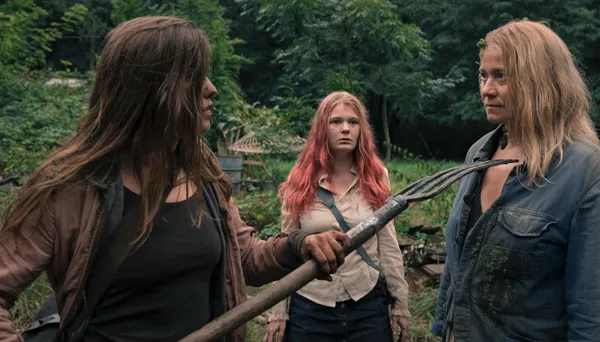 |
| Maja Lehrer, Gro Swantje Kolhof and Trine Dyrholm in Ever After |
A take on the collapse of civilisation that goes to very different places from those we are used to, Carolina Hellsgård’s Ever After (titled Endzeit in the original German) is a dazzlingly beautiful affair. It follows two young women, Vivi (Gro Swantje Kolhof) and Eva (Maja Lehrer) as they try to cross the zombie-infested land between Germany’s last two human-occupied cities. What makes it more unusual – and made me sit up and take notice despite the fact that I’m offered zombie films on a weekly basis – is that it’s made entirely by women. I asked Carolina how this came about.
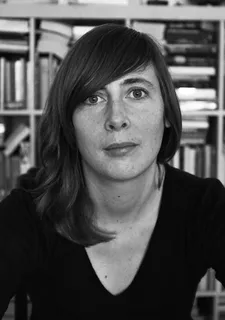 |
| Director Carolina Hellsgård |
“Olivia Vieweg wrote the script of this film,” she says. “Obviously there are two female protagonists. And then I met with Leah Striker, who’s the director of photography and we got along really well, and then we met with Jenny Rösler [the production designer] and we developed the concept for the film together and it just felt really right. I guess what I’m trying to say is that they’re very talented and capable people and they fit really well to the concept. I worked with them, like, I always work with women. For me it’s a natural thing, and in another way it fit the project.”
So they were just the right individuals for those jobs?
“Yeah. They were. I mean, we were trying to do like a baroque, almost a romantic horror film. They shared that vision with me.”
There’s a moment early on in the film where Vivi is given some hair dye and advised that the fortified city where she’s living could do with a bit of colour. That line seems to introduce what becomes an increasingly complex colour palette as we follow her on her journey. Was it important to the creative team to get away from the drabness of the average zombie film?
“Yeah. This idea actually came from the screenwriter, Olivia. She told me that for her, from the beginning, it was really, really important that it would be colourful and not a desaturated apocalyptic movie. I agreed with her and then together with Leah we developed a colour concept, so in the beginning it’s more like sepia and brown, and then as soon as we go out it becomes more like bluish greens, and then towards the end it’s greens and yellows and it’s very saturated. So we were really playing with these colours.”
There’s a scene in John Wyndham’s book Day Of The Triffids in which the hero returns to London a few years after the catastrophe has taken place to find it overgrown with plants. Was Carolina aiming for a similar effect in this film, with nature reclaiming spaces once occupied by humans?
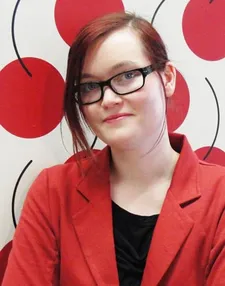 |
| Writer Olivia Vieweg |
“Yeah. I grew up in the Eighties so I really remember the Chernobyl catastrophe and what happened then and it’s something that I’ve been following my whole life. Also what happened ten years after the catastrophe and 20 years after. We all know, I mean it’s not a secret that nature is flourishing in Chernobyl because the people are gone, so nature’s taking over the buildings and the animals are wild and it was the source of my inspiration for Endzeit.”
The other thing the film reminded me of was George Romero’s Day Of The Dead, in which the heroine ultimate decides that she doesn’t want to spend her days fighting for the survival of the species and prioritises her own happiness instead. It’s a rare thing in zombie films, which mostly seem to share the same priorities.
“Yeah, I think you’re right. Also in The Girl With All The Gifts it’s about preserving the species, preserving humanity. I watched so many zombie movies and I decided I’m going to take an individualistic approach. Vivi and Eva are trying to navigate a new kind of existence where they will probably be fine. They don’t know that much about the rest of humanity. I think that if you’re not open to changes and a certain amount of chaos you will probably not thrive. And keeping it on a more personal level, it’s not so much about the survival of the species, it’s more about coexisting with others and with nature.”
That coexistence is rendered with some striking make-up effects where plants and humans blend together...
“This concept was of course already in the script, with the plants, and then the make-up artist, Katrin Westerhausen, she developed it – together with me, actually. We didn’t have an art director so we worked so hard, so long, to make the zombies aesthetically different. We wanted to move away from Walking Dead zombies.
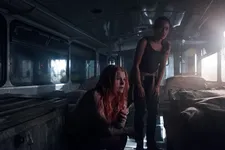 |
| Vivi and Eva's train breaks down |
“I’m really into phenomenology, which sounds weird in context but it’s about what’s inside a person, how it’s externalised, and for me the plants reflect the inner being of these people and they’re externalised in these various zombies. So that was my concept behind it. And Katrin took that and worked with original plants.”
Is there, perhaps, also something different about a zombie film focused on women, given that survival of the species narratives don’t allow women much hope of individual freedom?
“For me this film is really about emancipating oneself and being able to live however you want to live... Vivi, she’s quite a weak person in many ways. On the one hand she grows stronger as she becomes capable – she emancipates herself but she does it on her own terms. The essence of her is still there. She doesn’t become like a superhero or something.”
How did she go about casting for the film?
“We casted for such a long time!” she declares. “I was sometimes wondering if we will ever find anyone. I think we casted for one and a half years. I had seen Gro in a movie when she was just like 12 or something. It’s called Tore Tanzt [marketed in English as Nothing Bad Can Happen], it’s a German movie, and I really liked her in that film, so actually from the beginning I was very convinced that we should take her, but then we had to find the constellation that worked. It was very difficult to find two girls who are... they have to be really quite different mentally and physically and they still have to like each other, you still have to be able to believe that they will become friends, but not too quickly. There is kind of a power play going on between them.”
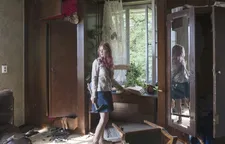 |
| Exploring abandoned spaces |
Another notable thing about the film is the way stories are told by the sets, especially as Vivi and Eva visit different places that other people have abandoned.
“I think the set designer, Jenny Rösler, she’s incredible. Her vision of the world, her attention to detail and the way she creates like little miniature worlds, she and her team – she had two assistants helping her – they did an amazing job, I would say. It fit really well with my and Leah’s vision. It felt almost like magic, in a way.”
The locations also contribute a lot.
“We went into nature reserve areas in Eastern Germany. Jenny went out and looked at locations about a year before and then we took some of them where we were very inspired by her views and then we tried to look for similar ones. We also had, unfortunately, some locations which I really loved but which didn’t work out because you’re not allowed to shoot there.”
So what’s next for Carolina>
“I’m actually shooting in four weeks,” she says. “I’m shooting my next film, which is kind of semi-autobiographical. It’s a fiction film called Sunburn. It’s about a young girl who is vacationing with her family in the south of Spain and she meets an immigrant on the beach, a Senegalese boy. He’s also just a kid – he’s 15 – and she promises to help him because he’s in a very difficult situation. So it’s really about to young kids trying to find their place in the world.”





















